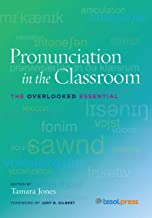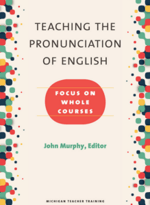Color Vowel® in Books and Articles
 Ahmad, K. (2016). Integrating pronunciation with vocabulary skills. In T. Jones (Ed.), Pronunciation in the classroom: The overlooked essential (pp. 1-16). Alexandria, VA: TESOL Publications.
Ahmad, K. (2016). Integrating pronunciation with vocabulary skills. In T. Jones (Ed.), Pronunciation in the classroom: The overlooked essential (pp. 1-16). Alexandria, VA: TESOL Publications.
Brinton, D. (2019). Innovations in pronunciation teaching. In O.Kang, R. I. Thomson, & J. M. Murphy (Eds.), The Routledge Handbook of Contemporary English Pronunciation (pp. 449-461). New York, NY: Routledge.
Katzenell, A. (2023). Theory and practice: Bite-sized activities for teaching reading skills. Ann Arbor, MI: University of Michigan Press.
Levis, J, Derwing, S. & Sonsaat-Hegelheimer, S. (2022). Second Language Pronunciation: Bridging the gap between research and teaching. Wiley-Blackwell.
Medina Gonzalez, Y.M. (2020). Teaching American English sounds to blind and low vision learners using assistive technology. Thesis paper submitted to Michigan State University.
 Mulyani Kone, A., Jannah, H., Hafzah, A. (2019). The implementation of Color Vowel Chart to enhance the EFL students' pronunciation at SMPN 1 Majauleng. Tamaddun Journal 18(2):110-132.
Mulyani Kone, A., Jannah, H., Hafzah, A. (2019). The implementation of Color Vowel Chart to enhance the EFL students' pronunciation at SMPN 1 Majauleng. Tamaddun Journal 18(2):110-132.
Taylor, K., & Schneider, C. (2017). The Color Vowel Chart: Teaching Pronunciation to Beginning-Level Adults. In J. Murphy (Ed.), Teaching the pronunciation of English (pp 285-306). Ann Arbor, MI: University of Michigan Press.
Sakach, A. N. (2022). Blue Canoe. CALICO Journal, 39(2):248–256. https://doi.org/10.1558/cj.18393
Syaifullah, S., Qoirum, Y., Andriani, R., & Herlinawati, H. (2022). Using the Color Vowel Chart in Teaching Speaking. ELT-Lectura, 9(2):136-150. https://doi.org/10.31849/elt-lectura.v9i2.10317 Wallace, L., & Fernandez, S. (2019). Teaching Tip: Personalizing peak vowel training in stressed syllables: A sneak peek at Blue Canoe for perception and production. In J. Levis, C. Nagle, & E. Todey (Eds.), Proceedings of the 10th Annual Pronunciation in Second Language Learning and Teaching Conference (pp. 423-433). Ames, IA: Iowa State University Press.
Wallace, L., & Fernandez, S. (2019). Teaching Tip: Personalizing peak vowel training in stressed syllables: A sneak peek at Blue Canoe for perception and production. In J. Levis, C. Nagle, & E. Todey (Eds.), Proceedings of the 10th Annual Pronunciation in Second Language Learning and Teaching Conference (pp. 423-433). Ames, IA: Iowa State University Press.
Yaw, Kate (2020). Technology review of Blue Canoe. In In O. Kange, S. Stapes, K. Yaw, & K. Kirschi (Eds.), Proceedings of the 11th Annual Pronunciation in Second Language Learning and Teaching Conference (pp. 360-367). Ames, IA: Iowa State University Press.
Academic Endorsements
“The Color Vowel Chart is a new, game-changing perspective for language teachers.”
“The Color Vowel approach reflects exactly what my research findings suggest: that the primacy of stress is key to the promotion of intelligibility, and our instructional priorities in L2 pronunciation should focus on how to teach stressed syllables and related characteristics. It promotes a hierarchical structure in the effect of the pronunciation features on learners’ oral proficiency.”
“With the time-saving Color Vowel Approach, my students and I share both a common language to refer to vowel sounds and a multi-modal approach to understand word stress and phrasal stress. By describing ‘circumference’ as ‘mustard’ and ‘circumstance’ as ‘purple,’ my students are able to understand and learn English rhythm and pronunciation confidently.”
THE COLOR VOWEL® CHART AND COLOR VOWEL® APPROACH
Annotated Bibliography
The Color Vowel® Approach reflects best practices in the field of English language teaching.
PRIORITIZATION OF STRESS AND VOWEL QUALITY
“Without a sufficient, threshold-level mastery of the English prosodic system, learners’ intelligibility and listening comprehension will not advance, no matter how much effort is made drilling individual sounds.”
- Judy Gilbert, educator and author of the Clear Speech textbook series and The Prosody Pyramid.
Gilbert, J. (2008). Teaching pronunciation: The prosody pyramid. New York, NY: Cambridge University Press.
Pennington, M., Pennington, M. C. (Ed.). (2021). The teaching of pronunciation [Special Issue]. RELC Journal, 52(1).
Pennington, M. C. (1989). Teaching pronunciation from the top down. RELC Journal, 20(1), 20– 38.
CATEGORICAL PERCEPTION AND BROCA'S AREA: HOW OUR BRAINS INHIBIT THE NOTICING OF L2 SOUNDS
Eimas PD, Siqueland ER, Jusczyk P, Vigorito J. (1971) Speech perception in infants. Science. 171:303–306.
Liberman, A.M., Harris, K.S., Hoffman, H.S., & Griffith, B.C. (1957). The discrimination of speech sounds within and across phoneme boundaries. Journal of Experimental Psychology, 54, 358-368.
Werker, J. F., & Tees, R. C. (1984). Cross-language speech perception: Evidence for perceptual reorganization during the first year of life. Infant Behavior & Development, 7(1), 49–63.
BYPASSING BROCA'S AREA TO NOTICE AND PRODUCE NEW SPEECH SOUNDS AND BEHAVIORS
Chan, M.J. (2018). Embodied pronunciation learning: Research and practice.The CATESOL Journal 30.1.
Eimas, P. D. (1991). Comment: Some effects of language acquisition on speech perception. In I. G. Mattingly & M. Studdert-Kennedy (Eds.), Modularity and the motor theory of speech perception (pp. 111-116). Hillsdale, NJ: Lawrence Erlbaum Associates, Inc.
Fowler, C. A., & Dekle, D. J. (1991). Listening with eye and hand: Cross-modal contributions to speech perception. Journal of Experimental Psychology: Human Perception and Performance, 17(3), 816–828.
Frost, D. (2023). Prosody in English pronunciation: Embodiment and metacognition. Université Grenoble Alpes.
Liberman, A. M., & Mattingly, I. G. (1985). The motor theory of speech perception revised. Cognition, 21, 1-36. Sheldon, Amy Louise, with Winifred Strange (1982). The acquisition of /r/ and /l/ by Japanese learners of English: Evidence that speech production can precede speech perception. Applied Psycholinguistics, 3(3), 243-61.
RESEARCH BASIS FOR PRIMING, FLOODING, AND CHORAL PRACTICE
“Neural networks corresponding to memories and all their connected associations arise in response to the stimuli that arrive to the brain. The robustness of long-term memories is directly related to the number of repetitions.”- Dr. Olle Kjellin, speech and learning expert formerly of the Research Institute of Logopedics and Phoniatrics at the Faculty of Medicine, University of Tokyo.
Kjellin, O. (n.d.). Choral practice - The neurophysiological opportunist’s way. Retrieved February 5, 2018
Kuhl, P. K. (1993). Innate predispositions and the effects of experience in speech perception: The native language magnet theory. In B. de Boysson-Bardies, S. de Schonen, P. Jusczyk, P. McNeilage, and J. Morton (Eds.), Developmental neurocognition: Speech and face processing in the first year of life, (pp. 259-274). Dordrecht, NL: Kluwer Academic Publishers.
Kuhl, P. K. (2000). Language, mind, and brain: Experience alters perception. In M.S. Gazzaniga (Ed.), The new cognitive neurosciences (2nd ed., pp. 99-115). Cambridge, MA: MIT Press.Tarone, E., & Meyers, C. (2018). The Mirroring Project: Improving suprasegmentals and intelligibility in ESL presentations. In R. A. Alonso (Ed.), Speaking in a second language (pp. 197–223). Amsterdam, the Netherlands: John Benjamins.
Subscribe to our mailing list
Enter your email address to our monthly newsletter.
